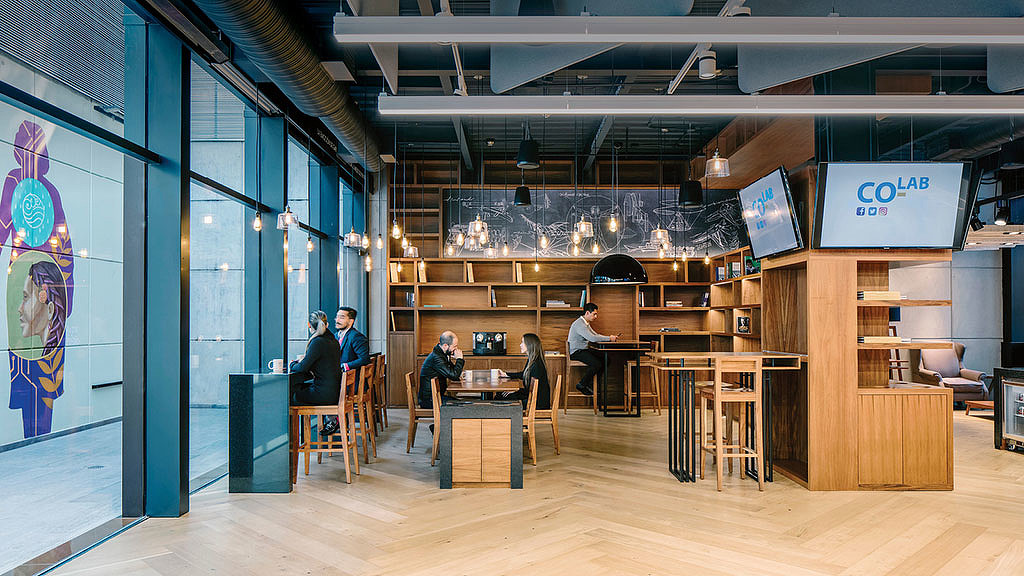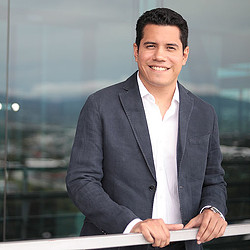What Gensler’s Mexico Workplace Survey Reveals About Why Employees Are Returning to the Office
Lo que revela la encuesta de Gensler sobre los espacios de trabajo en México acerca de por qué los empleados están regresando a la oficina
March 22, 2023 | By Francesca Poma-Murialdo and Daniel Alvarado
22 de marzo de 2023
Editor’s Note: This blog is part of our blog series exploring insights from Gensler’s 2022 Workplace Survey findings.
The Mexican business culture is well-known for placing a high value on interpersonal relationships, loyalty, and presence. So, it’s no surprise that Gensler’s recent Mexico Workplace Survey reveals that employees rate their professional development and scheduled, in-person meetings with their team and clients as the most important reasons to come into the office. This indicates that the office is a place where purposeful and meaningful interaction happens.
Gensler’s inaugural workplace survey of over 2,000 Mexico-based office workers uncovers some interesting surprises. We know that Mexico-based workers spend a third of their time working with others in-person and that this is an important factor in coming into the office, but the survey delves deeper to uncover which spaces and experiences are most effective in supporting employees. We also discovered that office workers report that they need to be in the office more than they currently are to maximize their productivity. If this is the case, what’s holding them back from coming into the office?
Return to office: If not when, then why?
Return to office efforts have been turbulent since the disruption of the pandemic. Industry reports have been speculating on when employees will return to the office, but few are asking why? Why, when employees have more choice and flexibility than ever, would they choose to come into the office over other places, such as their home or third spaces?
Mexico-based office workers have acclimated to hybrid working. On average, they spend almost one-quarter of their time in a typical working week in other locations, including alternative office locations, travel, coworking spaces, parks, libraries, and coffee shops. This increases to one-third of the time for more senior leadership. Despite this, workers across Mexico spend more time in their primary office (57%) than other countries such as the U.S. (51%) and Canada (53%), while the time spent at home is consistent with the average of 19%. This indicates that knowledge workers now require a more fluid structure in where they work in a typical work week, but this doesn’t mean it’s the end game for the office.
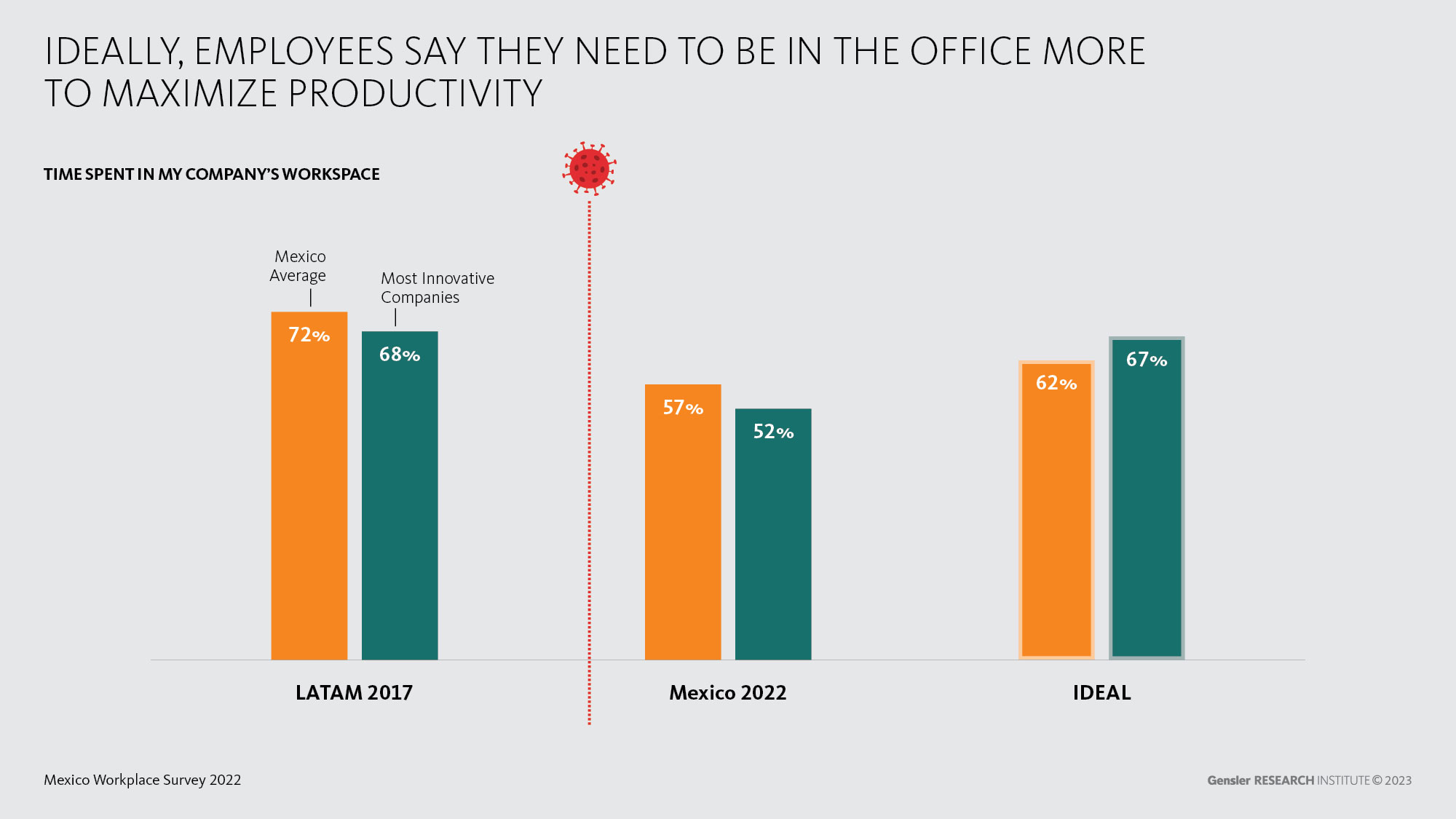
In fact, the office still holds an important role as the place where employees perceive they need to be to maximize their productivity. Workers in the most innovative companies report that they are spending 15% less time in the office than they were five years ago when compared to Mexico City–based workers in our LATAM Workplace Survey in 2017. Now, our data indicates that they report that they need to be in the office more regularly — closer to pre-pandemic levels — to maximize their productivity. But this begs the question, if employees say they need to be in the office more regularly to maximize their productivity, why don’t they?
What’s currently working in the office?
While the office is clearly an important facilitator and enabler of in-person meetings for Mexico-based office workers, we found that workers are spending more time working alone than they are working with others in-person in a typical work week. Workers also report that working alone is the most critical activity for their job performance. On average, workers spend 73% of their time at a desk — although this time decreases with seniority.
Our research reveals that today’s workplace effectively supports working together in-person, learning, and socializing, but it is less effective in supporting individual work and working together virtually. This insight exposes an opportunity to offer multi-functional workspaces that support working alone while maintaining the strength of collaboration and social spaces.
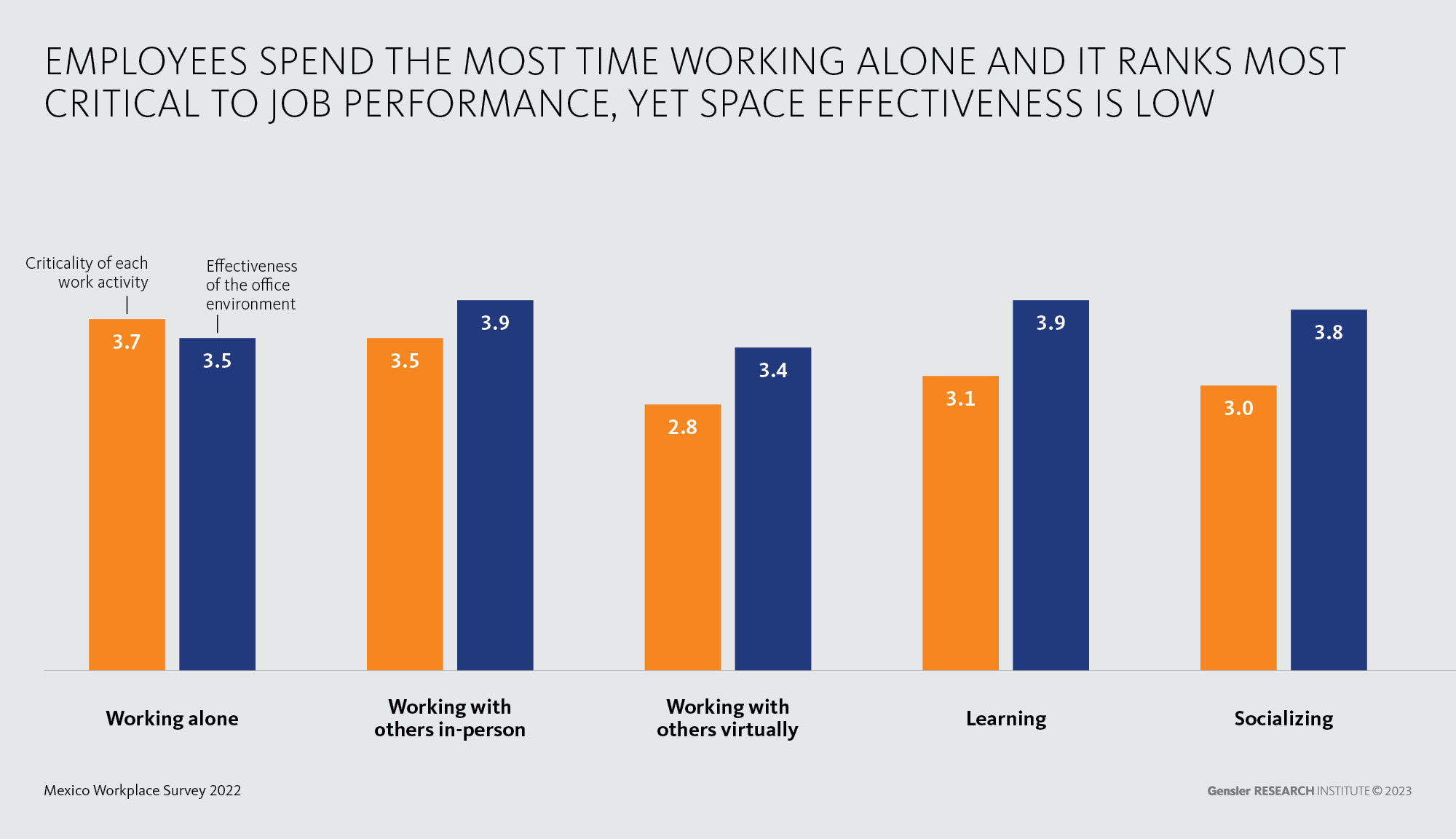
Wake up and smell the coffee
Experience is a critical ingredient in the success of return to office strategies. A great experience can be a powerful tool to increase the amount of time employees are willing to return to the office. But what types of experience count most? Mexico-based office workers show a clear preference for their office space to emulate a coffee shop experience. Respondents were asked to select their ideal blend of environments for their company’s office from eight possible options: clubhouse, boutique hotel, coffee shop, residential, library, conference center, creative lab, and corporate. Across all industries and age groups, the coffee shop experience came out on top. Other informal meeting experiences, such as that of a clubhouse, also ranked highly, highlighting workers’ desire for more interpersonal experiences.
More significantly, if organizations offered an employee’s ideal mix of experiences, 84% of employees who are not currently working from the office full-time would be more willing to come in. Almost three-quarters of workers report that they would be willing to return one more day per week, with 38% of those who are currently in the office less than full-time indicating that they would be willing to come back five days per week. While there is no single ‘ideal’ mix of experiences, this data indicates that a blend of new experiences could influence more employees to return to the office.
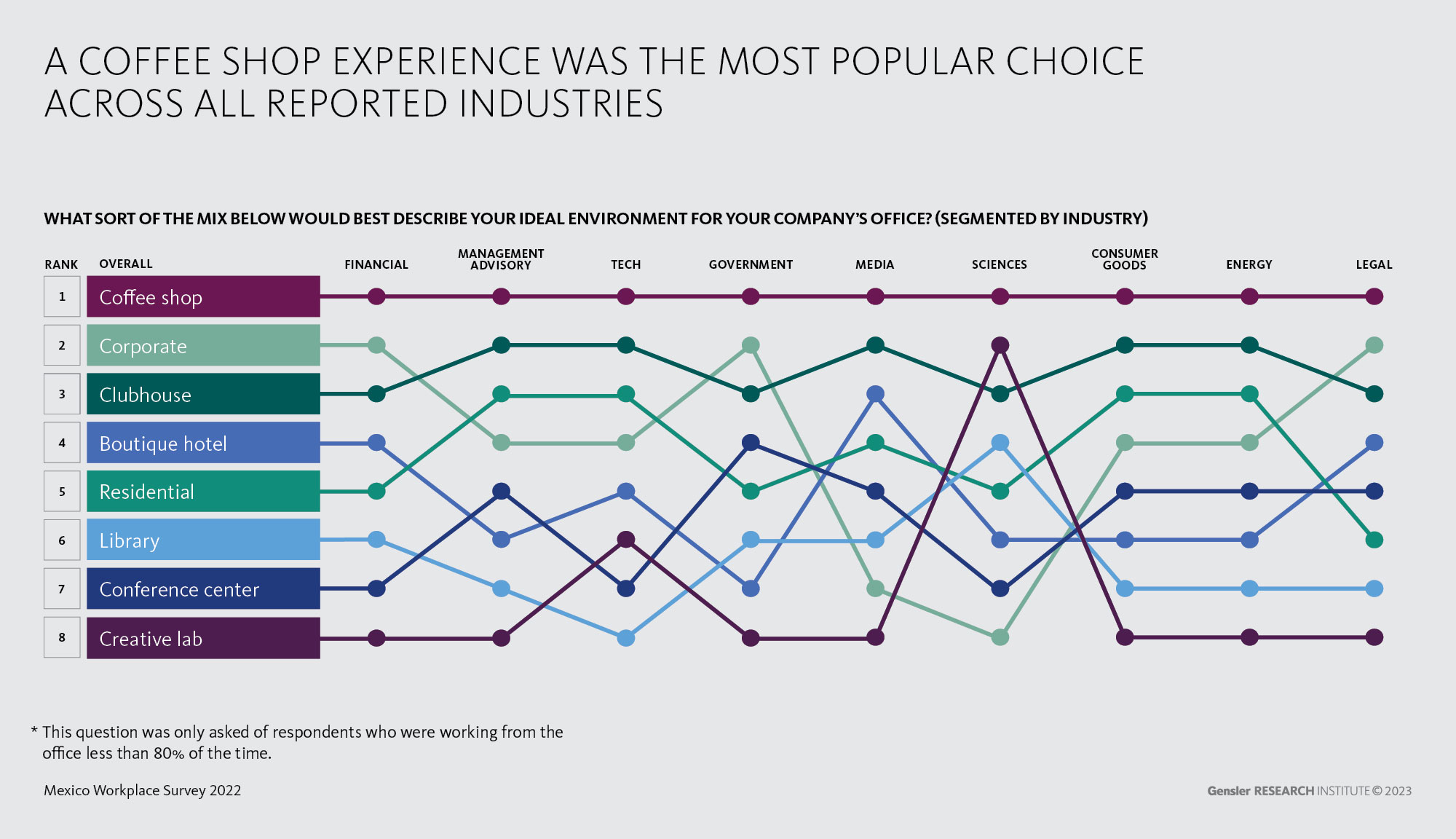
What spaces make the biggest impact?
While in-person team meetings and professional development were the primary reasons to come into the office, almost half of Mexico-based workers said that having access to specific spaces, materials, and resources was also important. Some of these spaces drive greater impact for space effectiveness and experience than others. Based on Gensler’s Workplace Performance Index (WPIx) and Experience Score, we identified that food amenities, spaces for creative group work, and spaces for quiet individual work have the greatest impact of space effectiveness and experience.
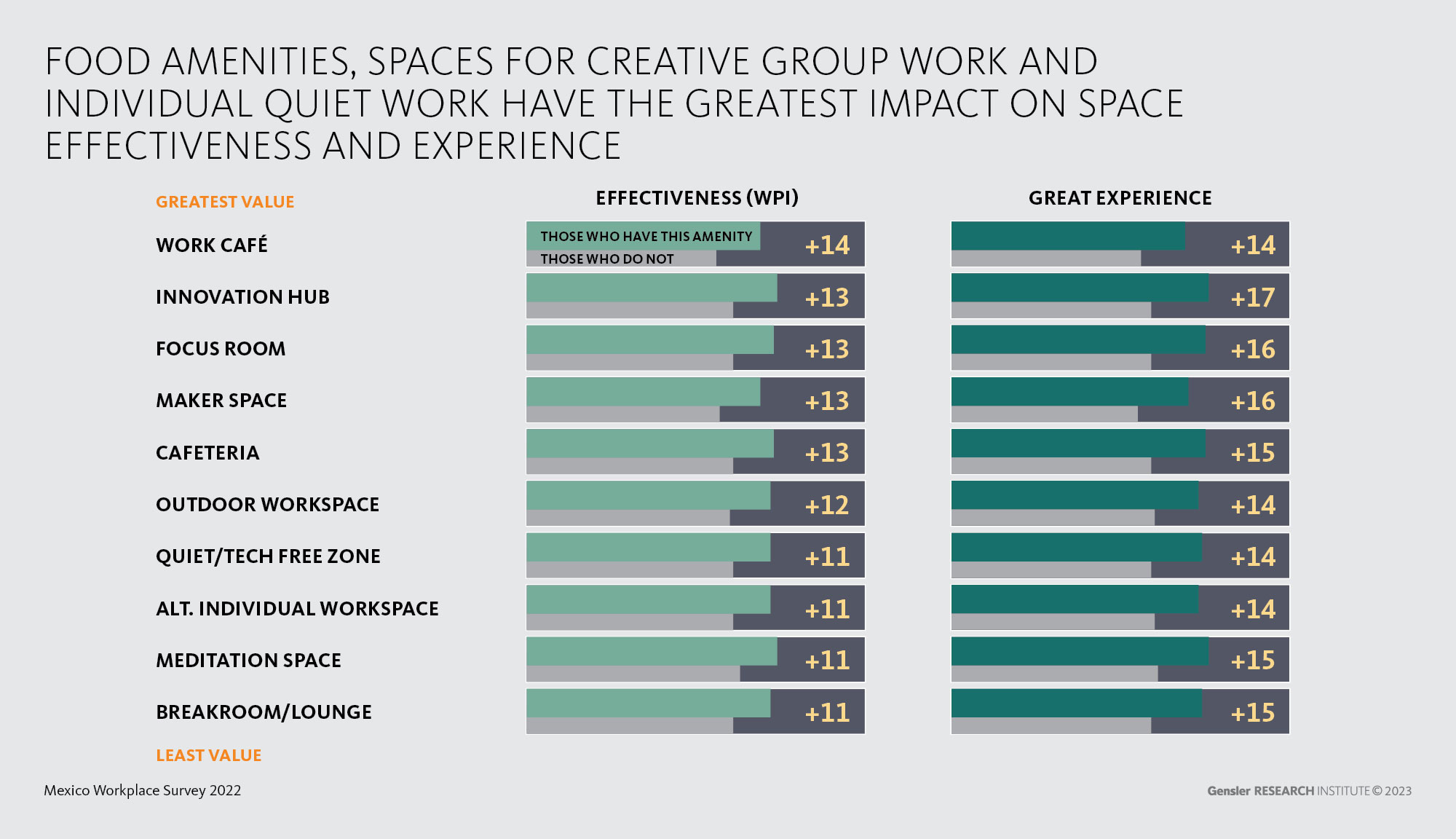
While work cafes are the biggest driver of space effectiveness, innovation hubs, maker spaces, and focus rooms offer the greatest experience — despite less than 45% of companies providing these spaces. These spaces respond to the type of work that Mexico-based workers are engaging in during a typical work week. Work cafes and cafeteria spaces offer spaces for workers to informally meet in person, while maker spaces and innovation hubs provide access to specific resources and tools. Unsurprisingly, focus rooms rank highly for both space effectiveness and experience due to the amount of time employees spend working alone. These spaces should no longer be part of the ‘amenity’ package organizations are offering employees. Instead, they should be staple spaces that are readily accessible for all employees when they come into the office.
As hybrid working becomes a more permanent fixture in the work landscape, workers across Mexico will have more choice in where they work. To remain an attractive place where people choose to work, the office should respond to employees’ specific needs and expectations.
As workers in Mexico seek more meaningful and purposeful interactions when they come into the office, design should be more intentional than ever. Just as our body language serves as a powerful non-verbal tool for communication and representation, the office acts as the first impression for an organization. Purposeful and attractive workplace design that offers a blend of different experiences not only has the potential to attract employees back, but it also has positive implications for business success.
Download the full Mexico Workplace Survey 2022 briefing to explore more insights. Stay tuned for additional blogs in this series.
For media inquiries, email .
Nota del Editor: Este blog es parte de nuestra colección de artículos que exploran los hallazgos de la Encuesta de Gensler sobre Espacios de Trabajo 2022.
La cultura empresarial mexicana es conocida por dar un alto valor a las relaciones interpersonales, la lealtad y la presencia. Por lo tanto, no es ninguna sorpresa que la reciente Encuesta de Gensler sobre Espacios de Trabajo en México revele que los empleados califiquen su desarrollo profesional y las reuniones presenciales con su equipo y clientes como una de las razones más importantes para acudir a la oficina. Esto indica que la oficina es el lugar en donde ocurren interacciones de valor significativo y especialmente con propósito.
La primera encuesta de Gensler sobre los Espacios de Trabajo (WPS México por sus siglas en inglés), realizada a más de 2,000 colaboradores mexicanos, revela algunas sorpresas interesantes. Sabemos que los mexicanos pasan un tercio de su tiempo trabajando presencialmente con otras personas siendo esto un factor importante para acudir a la oficina, pero la encuesta profundiza para descubrir cuales espacios y experiencias son más eficaces para apoyarlos. También encontramos que los colaboradores afirman que necesitan estar en la oficina, más tiempo del que asisten actualmente, para maximizar su productividad. Si este es el caso, ¿qué les impide volver?
Volver a la oficina: La pregunta no es cuándo, sino ¿por qué volver?
Los esfuerzos por volver a la oficina han sido turbulentos desde la interrupción de la pandemia. Los informes del sector han especulado sobre cuándo volverán los colaboradores a la oficina, pero pocos se preguntan por el motivo. ¿Por qué, cuando los empleados tienen más opciones y flexibilidad que nunca, elegirían volver a la oficina en lugar de otros lugares, como su casa o espacios remotos?
Los mexicanos se han adaptado al trabajo híbrido. En promedio en una semana laboral típica, pasan casi una cuarta parte de su tiempo en otros lugares, como oficinas alternas, viajes, espacios de coworking, parques, bibliotecas o cafeterías. Esta cifra aumenta a un tercio del tiempo en el caso de los altos directivos. A pesar de esto, los colaboradores en México pasan más tiempo en su oficina principal (57%) que otros países como Estados Unidos (51%) y Canadá (53%), mientras que el tiempo que pasan en casa es consistente con el promedio de 19%. Esto indica que los colaboradores ahora requieren una estructura más fluida en cuanto a dónde trabajan en una semana laboral típica, pero esto no significa que sea el fin del juego para la oficina.
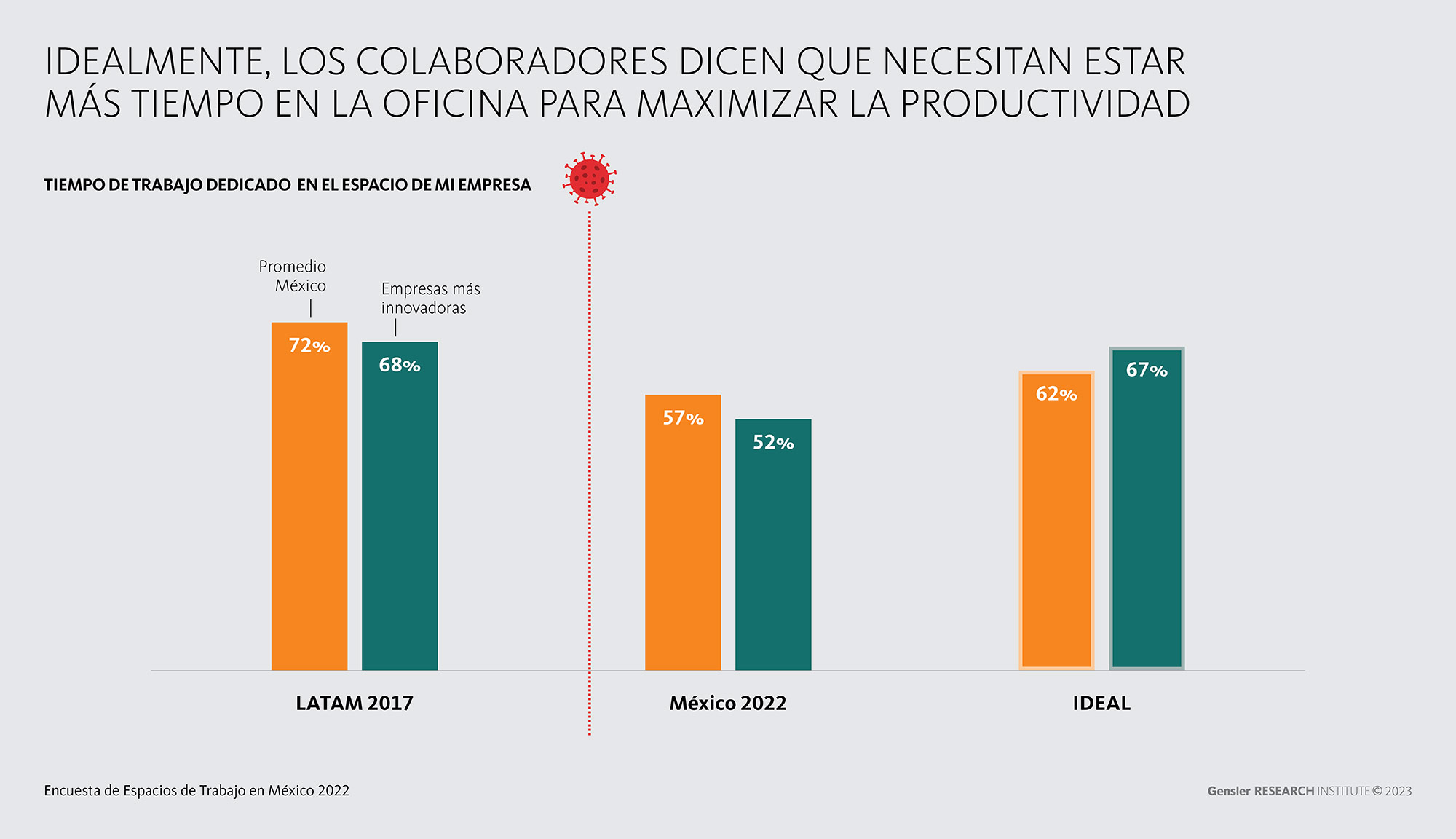
De hecho, la oficina sigue teniendo un papel importante como el lugar en donde perciben que necesitan estar para maximizar su productividad. Los colaboradores de las empresas más innovadoras informan que pasan 15% menos tiempo en la oficina que hace cinco años, en comparación con los colaboradores de la Ciudad de México en nuestra encuesta LATAM Workplace Survey de 2017. Ahora, nuestros datos indican que necesitan estar en la oficina con mayor regularidad -más cerca de los niveles prepandémicos- para maximizar su productividad. Pero esto plantea la pregunta, si los empleados dicen que necesitan estar en la oficina con más regularidad para maximizar su productividad, ¿por qué no lo hacen?
¿Qué funciona actualmente en la oficina?
Si bien la oficina es claramente un importante facilitador y propiciador de reuniones en persona para los colaboradores en México, descubrimos que los empleados pasan más tiempo trabajando solos que trabajando presencialmente con otras personas en una semana laboral típica. Los empleados también informan de que trabajar solos es la actividad más crítica para su rendimiento laboral. En promedio, pasan el 73% de su tiempo en un escritorio, aunque este tiempo disminuye con la antigüedad.
Nuestra investigación revela que el lugar de trabajo actual apoya eficazmente el trabajo colaborativo presencial, el aprendizaje y la socialización, pero es menos eficaz a la hora de apoyar el trabajo individual y el trabajo colaborativo virtual. Este dato nos brinda la oportunidad de ofrecer espacios de trabajo multifuncionales que permitan trabajar de manera individual sin perder la fuerza de los espacios sociales y de colaboración.
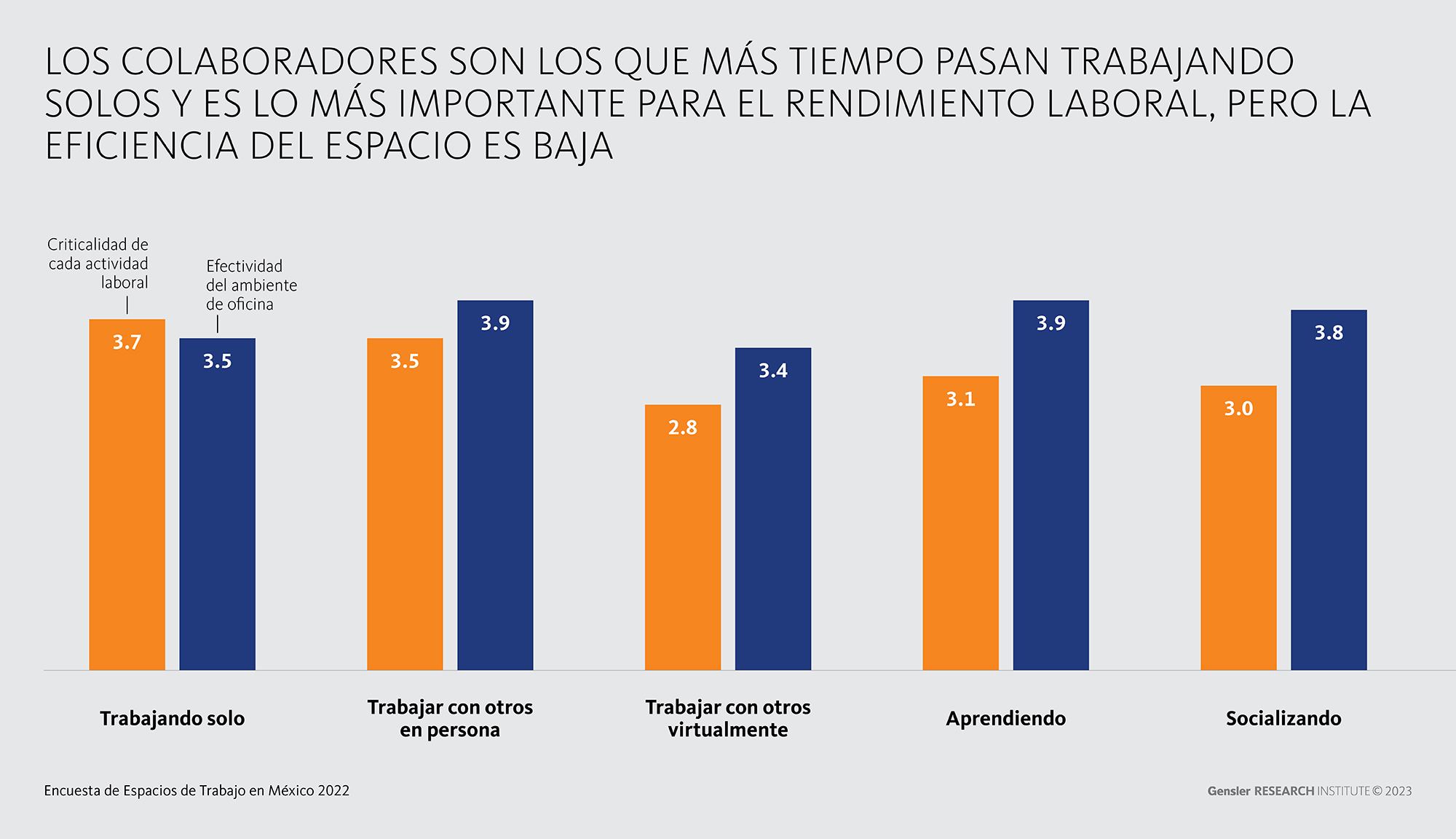
Despierta y huele el café
La experiencia es un ingrediente fundamental para el éxito de las estrategias de regreso a la oficina. Una gran experiencia puede ser una herramienta poderosa para aumentar el tiempo que los empleados están dispuestos a volver a la oficina. Pero ¿qué tipo de experiencia cuenta más? Los colaboradores en México muestran una clara preferencia por que su espacio de oficina emule la experiencia de un work café. Se pidió a los encuestados que seleccionaran su combinación ideal de experiencias para la oficina de su empresa entre ocho opciones posibles: club social, hotel boutique, work café, residencial, biblioteca, centro de conferencias, laboratorio creativo y corporativo. En todos los sectores y grupos de edad, siendo la principal la experiencia de work café. Otras experiencias de reuniones informales, como la de un club social también obtuvieron una alta puntuación, esto subraya la importancia y el deseo que los colaboradores tienen de vivir experiencias más interpersonales.
Y lo que es más significativo, si las organizaciones ofrecieran la combinación ideal de experiencias para los colaboradores, el 84% que actualmente no trabaja desde la oficina estarían dispuestos a acudir más frecuencia. Casi tres cuartas partes de los trabajadores afirman que estarían dispuestos a volver un día más a la semana, y el 38% de los que actualmente están en la oficina algunos días a la semana indican que estarían dispuestos a volver cinco días a la semana. Aunque no existe una única combinación “ideal” de experiencias, estos datos indican que una mezcla de nuevas experiencias podría influir en un mayor número de colaboradores para volver a la oficina.
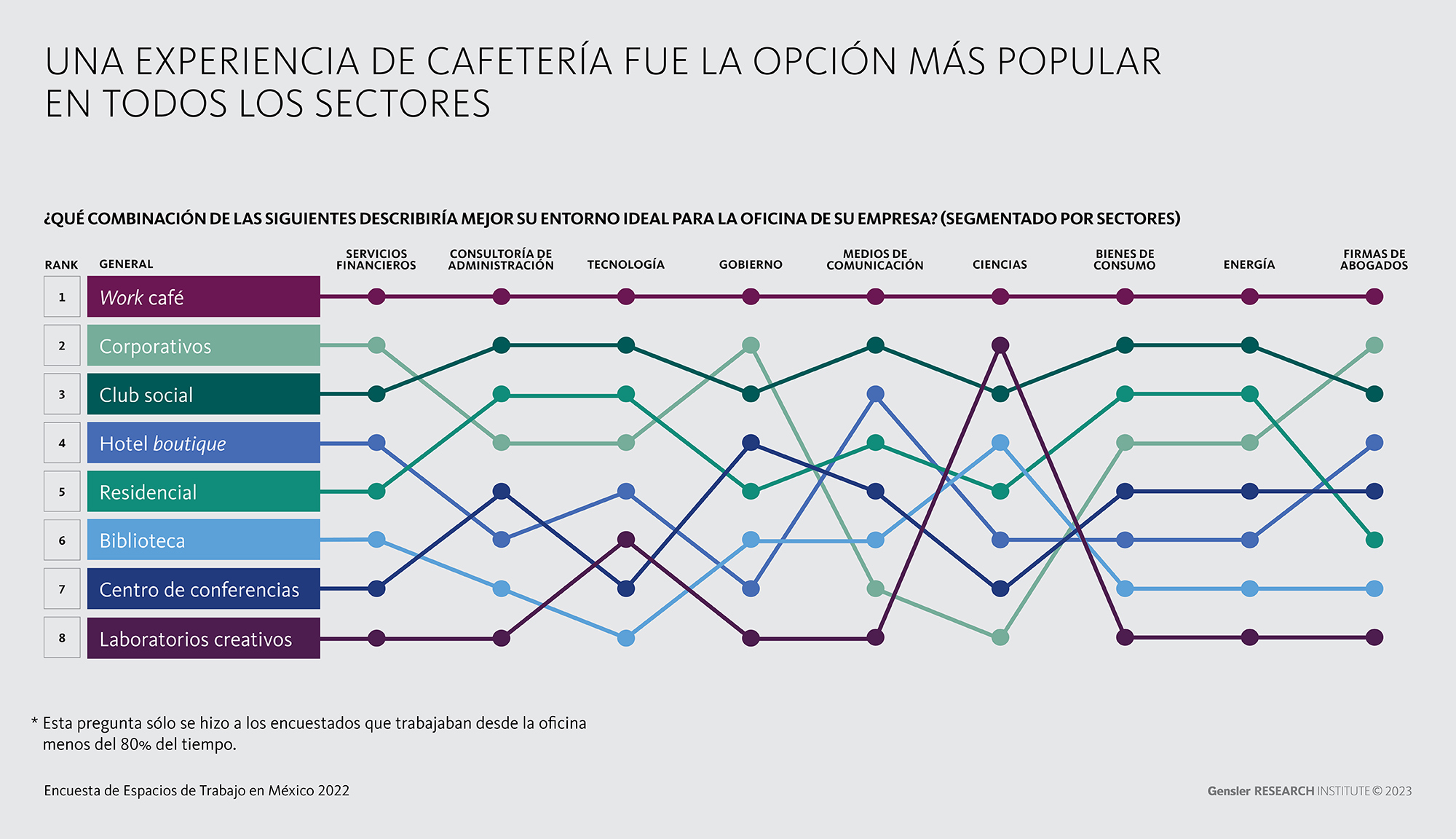
¿Qué espacios tienen mayor impacto?
Aunque las reuniones de equipo presenciales y el desarrollo profesional fueron las principales razones para acudir a la oficina, casi la mitad de los colaboradores en México afirmaron que tener acceso a espacios, materiales y recursos específicos también era importante. Algunos de estos espacios tienen un mayor impacto que otros en la efectividad y experiencia del lugar. Con base en el Índice de Desempeño del Lugar de Trabajo (WPIx, por sus siglas en inglés) y la Puntuación de Experiencia de Gensler, identificamos que los servicios de comida, los espacios para el trabajo creativo grupal y los espacios para trabajo individual tranquilo tienen el mayor impacto en la efectividad y experiencia del espacio.
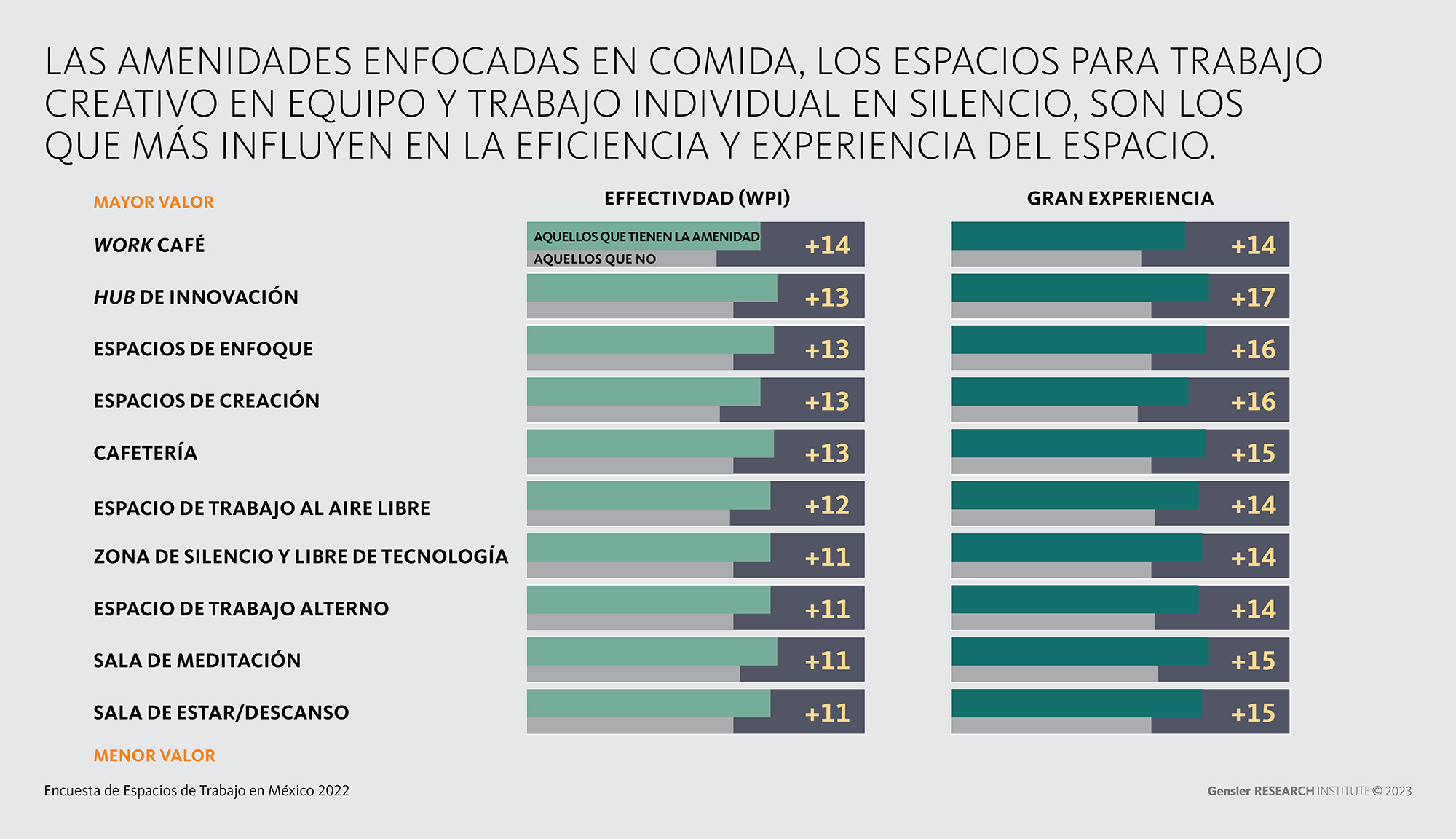
Mientras que los espacios tipo work cafés son el mayor impulsor de la eficiencia del espacio, los centros de innovación, los espacios para creadores y las salas de enfoque ofrecen la mayor experiencia, a pesar de que menos del 45% de las empresas los ofrecen. Estos espacios responden al tipo de trabajo que los colaboradores mexicanos realizan durante una semana laboral típica. Los work cafés y las cafeterías ofrecen espacios para que se reúnan informalmente en persona, mientras que los espacios de fabricación y los hubs de innovación proporcionan acceso a recursos y herramientas específicas. Como era de esperar, las salas de reuniones ocupan un lugar destacado tanto por la eficacia del espacio como por la experiencia, debido a la cantidad de tiempo que los colaboradores pasan trabajando solos. Estos espacios ya no deberían formar parte del paquete de "servicios" que las organizaciones ofrecen. Por el contrario, deben ser espacios básicos a los que todos puedan acceder fácilmente cuando entren en la oficina.
A medida que el trabajo híbrido se convierte en un elemento más permanente en el panorama laboral, los colaboradores de todo México tendrán más opciones para elegir dónde trabajar. Para seguir siendo un lugar atractivo donde la gente elija trabajar, la oficina debe responder a las necesidades y expectativas específicas de todos.
Dado que los colaboradores en México buscan interacciones más significativas y con propósito cuando llegan a la oficina, el diseño debe ser más intencional que nunca. Así como nuestro lenguaje corporal sirve como una poderosa herramienta no verbal para la comunicación y la representación, la oficina actúa como la primera impresión para una organización. Un diseño intencional y atractivo del espacio de trabajo que ofrezca una mezcla de diferentes experiencias no sólo tiene el potencial de atraer a los empleados de vuelta, sino que también tiene implicaciones positivas para el éxito empresarial.
Descargue el informe completo Mexico Workplace Survey 2022 para obtener más información. Esté atento a otros blogs de esta serie.
Para consultas de los medios de comunicación, envíe un correo electrónico a .
